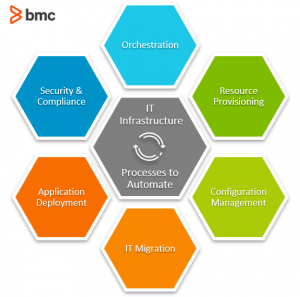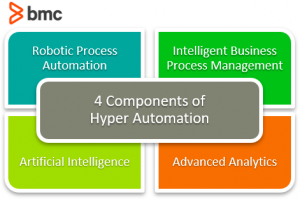Modern applications are dynamic, constantly growing to accommodate large volumes of data generated by users and devices. This typically requires software teams to constantly provision new deployment environments or reconfigure existing ones to keep the applications running smoothly. Unfortunately, manual provisioning and infrastructure configuration is:
- Painstakingly slow
- Inefficient
- Prone to failure from human error
This is where infrastructure automation comes in.
This article explores why software organizations need infrastructure automation, and how it helps improve technical and business outcomes.
What is infrastructure automation?
IT infrastructure automation aims to simplify IT operations while improving speed and agility by enabling software teams to perform various management tasks with minimal human intervention. By reducing the manual effort involved in provisioning and managing workloads, IT automation enables teams to focus on strategic processes that add business value.
(Read our IT infrastructure primer.)
Basics of IT automation
A typical IT ecosystem contains a magnitude of components distributed across various layers of IT infrastructure. These components require numerous repetitive and manual processes to manage, maintain, and update.
To deal with this, organizations automate processes that improve the speed and agility of product delivery without raising the cost and complexity of running infrastructure. IT automation strategies also include standardization of compliance policies, which enforce mandatory regulations and reduce security attack surfaces.
Embracing automation is considered as crucial as comprehensive digital transformation—without it, you risk your competitive edge.
Benefits of infrastructure automation
Automation eliminates manual provisioning and handling of underlying infrastructure processes, enabling the rapid development of secure, scalable applications. Some benefits of infrastructure automation include:
- Reducing human error. Automation eliminates vulnerabilities typically associated with human error during manual provisioning. By reducing manual efforts, IT teams focus on core development and innovation rather than investing efforts on iterative processes.
- Reducing infrastructure complexity. Automation reduces the cost and effort to implement and manage IT infrastructure. By reducing the administrative burden of performing repetitive tasks, operations teams deal with known complexities, a predictive framework that allows operations teams to optimize infrastructure for an enhanced user experience.
- Enhancing workflows. Automation allows for repeatability, predictability, and accuracy when performing IT provisioning tasks. Operations teams only need to set the desired conditions for the provisioning of infrastructure, while automation tools execute the tasks needed when the right conditions are met.
- Speeding up delivery and deployment. By autonomously executing repetitive workflows across multiple machines, automation significantly reduces the time taken to configure IT infrastructure. This means teams can develop products faster and reduce the overall time-to-market.
How infrastructure automation works
Automating infrastructure can seem daunting. Fortunately, several factors that ensure the key features of IT infrastructure remain intact.
Standard operating environments
The first step to automating infrastructure is to define standard operating environments (SOEs) for servers and workstations. An SOE defines a specific operating system combined with the associated software and hardware configurations needed to deploy and run application workloads within the organization’s IT ecosystem. An SOE definition typically considers the following components:
- Operating system
- Service packs
- Common applications
- Associated dependencies
By making IT infrastructure management processes predictable and repeatable, SOEs enforce a common standard for consistent and timely maintenance.
Infrastructure as code
One critical aspect of automation is to abstract the management of underlying infrastructure using the same principles that govern coding in DevOps—a concept known as infrastructure as code (IaC).
This allows software teams to create target environments using configuration files of pre-defined formats such as JSON or YAML. These machine-readable files rely on declarative or imperative commands to manage policies through centralized templates and automation libraries, thereby simplifying resource and application configuration.
Infrastructure as Code also helps organizations achieve uniformity across different deployment environments, allowing for simple automation of multi-cloud or hybrid deployments.

How to automate IT infrastructure
Automation helps reduce the cost and complexity of running IT infrastructure—yet doing so requires careful planning, since not all components of the ecosystem can be automated. This section explores the IT processes that organizations typically automate. Automation is mostly used to fast-track tasks that are:
- Repetitive
- Well-documented
- Self-contained
- Tedious
While use cases differ for different organizations, an organization with a typical IT setup automates the following processes:
Orchestration
Robust automation solutions include capabilities to:
- Automate different processes
- Manage configurations across multiple nodes/machines
(Compare automation to orchestration.)
Resource provisioning
Automation works in collaboration with orchestration to run software defined networks, storage devices, virtual machines, and data centers for seamless workload handling. While doing so, automation tools enable systems to meet business demands by autonomously scaling resource capacity across multiple environments.
Configuration management
Automation enables teams to efficiently unify operations across disparate machines and deployment environments since it allows staff to define infrastructure as code. With automation tools, teams simplify configuration management using predefined scripts and best practices that are shared throughout the organization.
IT migration
Automation allows companies to move operating systems, applications, and data faster and smoother than manual processes since deployment relies on standard operating environments.
Application deployment
Automated systems perform essential testing tasks while also allowing for seamless CI/CD by providing a repetitive, proven, and secure approach of moving from commit to build to testing to deployment.
(Build your own CI/CD pipeline.)
Security & compliance
Automation lets security teams define compliance and risk management policies using IaC declarations, then automatically uses them as automatic guidelines when provisioning infrastructure.
Popular IT infrastructure automation solutions
Of course, tools can help any organization jumpstart the automation journey. Some of the most popular automation tools include:
- Ansible. An open-source enterprise automation tool that uses collections of pre-composed content for quick implementation of automation projects.
- Terraform. A declarative, open-source coding tool that uses pre-configured modules to allow the configuration of multiple, clustered infrastructure resources.
- Puppet. An open-source server management and configuration tool that uses a Domain-Specific Language and desired state management for automation.
- Chef. An enterprise dashboard and analytic platform that allows for complete code visibility and IT automation through collaboration and real-time resource scaling.
- Saltstack. A data-driven remote execution and orchestration tool that also allows for infrastructure management and automation.
- Cloudformation. An IaC platform that uses templates to allow for modelling of related AWS resources, managing their lifecycles and quick provisioning.
(Automate infrastructure with these BMC solutions.)
Infrastructure (hyper)automation
Efficiency of an infrastructure is often measured by the levels of automation and reduced human interaction. While lifecycle of certain processes are limited, the rule of thumb for automation is always to scope those that are repetitive or requires a standardized set of steps.
Infrastructure adoption is on the rise, with Gartner predicting that organizations will refocus over 30% of their IT operations on analytics and automation capabilities—something known as hyperautomation. With more firms adopting hybrid and multi-cloud deployments, the need for enterprise automation solutions to help manage infrastructure provisioning continues to grow.

Related reading
- BMC IT Operations Blog
- Ansible vs Control-M: How Are They Different?
- Gain Complete Visibility into Today’s Complex IT Infrastructures
- Converged vs Hyperconverged Infrastructure: The Differences Between CI & HCI
- Automation In DevOps: Why & How To Automate DevOps Practices
- IT Automation Trends To Watch in 2021







